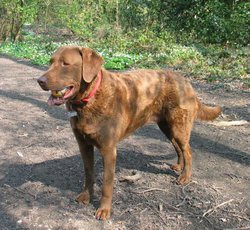
|
From Wikipedia the free encyclopedia, by MultiMedia |
| Chesapeake Bay Retriever | ||
|---|---|---|

Chesapeake Bay Retrievers have a distinctive curly or
wavy coat that is often oily-looking.
|
||
| Alternative names | ||
| Country of origin | ||
| United States | ||
| Common nicknames | ||
| Chessie | ||
| Classification and breed standards | ||
| FCI: | Group 8 Section 1 #263 | |
| AKC: | Sporting | |
| ANKC: | Group 3 (GunDogs) | |
| CKC: | Group 1 - Sporting Dogs | |
| KC (UK): | GunDog | |
| NZKC: | GunDog | |
| UKC: | Gun Dog Breeds | |
| Not recognized by any major kennel club | ||
| This breed of Dog is extinct | ||
| Notes | ||
The Chesapeake Bay Retriever is a breed of Dog that was developed along the Chesapeake Bay to hunt waterfowl under adverse weather and water conditions, often having to break ice during the course of many strenuous multiple retrieves. The breed was used not only to retrieve the game, but also sat in the boat and on the wagon when the game was taken to market in order to protect the load from theft. Thus, the breed is very protective of its people and property. Many owners refer to this breed as "Chessies".
Distinctive features include eyes that are very clear, of yellowish or amber hue, hindquarters as high or a trifle higher than the shoulders, and a double coat that tends to wave on shoulders, neck, back and loins. This "waterproof" coat feels slightly oily compared to other members of the same family. Three basic colors are generally seen in the breed: brown, which includes all shades from a light cocoa (a silvered brown) to a deep bittersweet chocolate color; sedge, which varies from a reddish yellow through a bright red to chestnut shades; and deadgrass, which takes in all shades of deadgrass, varying from a faded tan to a dull straw color. The breed standard states that white may also appear, but it must be limited to the breast, belly, toes, or back of the feet.
The Chesapeake is valued for its bright and happy disposition, intelligence, quiet good sense, and affectionate protective nature. The breed is very loving and makes a wonderful companion.
Some Chessies become vocal while happy; while this can be mistaken for a growl it is only a sign of happiness and not intended to create alarm. In addition, some Dogs will 'smile' when happy by baring their front teeth in a peculiar grin; again this is not a threat but a sign of joy.
The Chesapeake is natually dominant and, while usually won't start a fight over dominance, the breed will defend his position as the alpha Dog. For the casual pet owner, it is usually not a good idea to have more than one Chesapeake because of dominance issues.
The Chesapeake tends to recognize only one person or family as master. All other people are considered by the Dog to be either equal or subordinate. In order to keep the Dog from attempting to become the alpha family member, the Dog's master should regularly reinforce dominance over the Dog by issuing a command such as 'come' or 'sit' at a time when the Dog would rather not do so.
The breed is very tolerant of pain, which makes it difficult to tell when they're injured. This trait also makes Chessies tolerant of roughhousing from young children; when they have had enough they typically move away rather than snap at or otherwise attempt to correct the child for their behavior.
Training is a necessity with this breed. The trainer must exercise more patience than with most other breeds as this breed is usually not willing to change its behaviour.
The Chesapeake Bay Retriever is a very intelligent breed and learns faster than most other breeds. Once a Chesapeake learns what is expected, he will act accordingly from that point on. A Chesapeake is not willing to break the rules and will attempt to enforce the same rules on subordinate Dogs.
During training, if a Chesapeake is asked to perform something that he believes is against the rules, he will flatly refuse. This has earned the breed the reputation of being very stubborn. This reputation is not deserved. The trainer must take into account that the Dog is being asked to do something that he has previously been taught not to do.
A Chesapeake's greatest joy is pleasing its master. While giving treats as a reward for good behaviour works well much of the time, the Dog also responds very well to scolding from its master in response to bad behaviour. A stern scolding followed by forgiveness goes a long way in gaining the animal's trust.
There is a phase that applies to Chesapeakes - "You can order a lab; ask a golden; but you must negotiate with a Chesapeake."
Dogs, made by MultiMedia | Free content and software
This guide is licensed under the GNU Free Documentation License. It uses material from the Wikipedia.